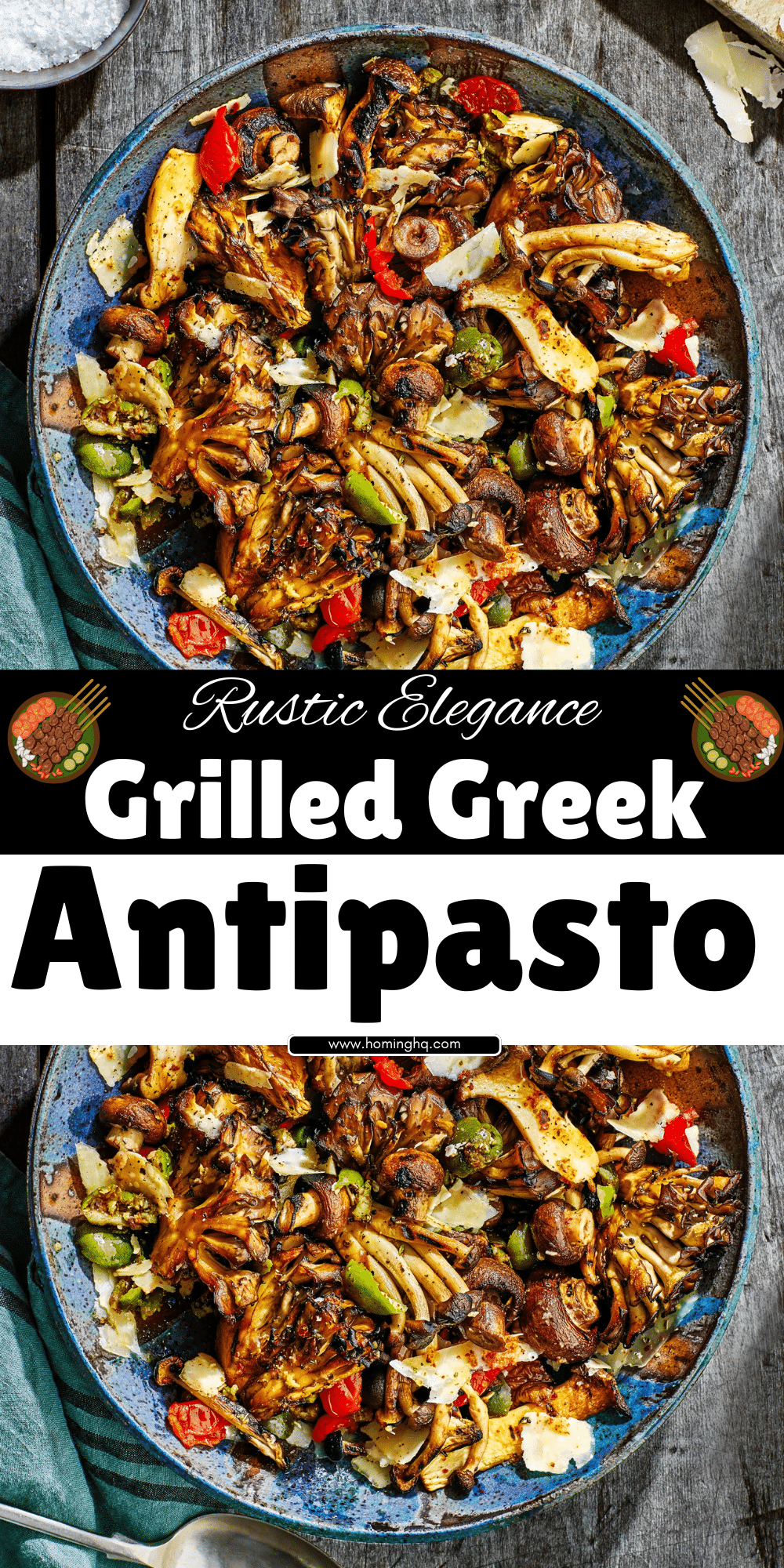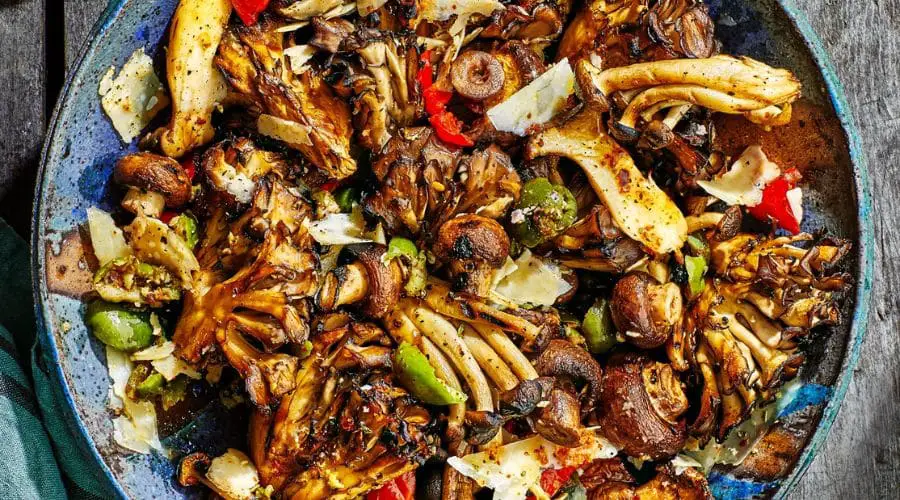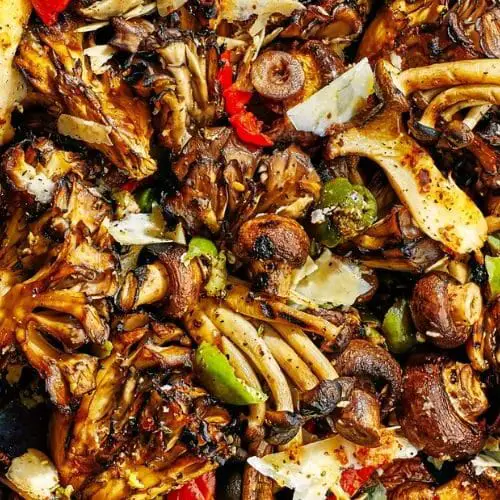All products are selected by our editorial team for quality. If you buy through our links, we may earn a small commission at no extra cost to you.
Grilled Greek Antipasto is a celebration of fresh Mediterranean flavors, combining smoky grilled vegetables, savory meats, creamy cheeses, and briny olives, all brought together with a zesty dressing.
This dish is more than just an appetizer; it’s a medley of textures and tastes that transport you to the sun-drenched shores of Greece.
Whether you’re hosting a lively gathering or preparing a light, flavorful meal, this grilled antipasto is sure to impress with its vibrant colors and tantalizing flavors.
With the rich history of Greek cuisine, antipasto offers a glimpse into the heart of the Mediterranean.
The grilling process adds a depth of flavor that makes this dish irresistible, and it can easily be customized based on personal taste or available ingredients.
Let’s dive into the world of Grilled Greek Antipasto and discover why it’s the perfect addition to your culinary repertoire.

What is Greek Antipasto?
Greek antipasto, often referred to as “meze,” is a diverse assortment of appetizers or small dishes that are typically served as part of a larger Mediterranean meal.
Rooted in Greek tradition, it emphasizes fresh, local ingredients that are full of flavor.
These dishes often feature staples such as olives, feta cheese, roasted vegetables, and various types of meats like lamb, chicken, or seafood.
Unlike the Italian antipasto, which may focus more on cold cuts and cheeses, Greek antipasto revolves around a combination of grilled or marinated ingredients, which provide a smoky and aromatic flavor.
The key to its authenticity lies in the quality of olive oil, herbs like oregano and thyme, and the balance between fresh vegetables, cheeses, and the briny sharpness of olives.
In its simplest form, a Greek antipasto platter may include grilled vegetables like zucchini and eggplant, tangy feta cheese, and a variety of olives, but it’s the addition of grilled meats, seafood, and a drizzle of Greek dressing that elevate this dish to a whole new level.
Why Choose Grilled Greek Antipasto?
Grilling transforms simple ingredients into something extraordinary.
When it comes to Greek Antipasto, the smokiness of the grilled vegetables and proteins adds depth, enhancing the natural flavors of the ingredients.
The high heat of the grill also caramelizes sugars in vegetables, creating a slight char that adds complexity to the dish.
One of the reasons this dish is so beloved is its versatility.
It can easily be tailored to fit various dietary needs, whether you prefer vegetarian options, lean meats, or a mix of both. It’s also a dish that can be made ahead of time, making it an ideal choice for parties or family gatherings.
The combination of ingredients used in Grilled Greek Antipasto is rich in health benefits as well.
Fresh vegetables and lean proteins provide nutrients, while heart-healthy olive oil and tangy feta cheese offer flavors that perfectly complement one another.
Whether you’re looking to make a light, refreshing appetizer or a more substantial meal, Grilled Greek Antipasto offers the best of both worlds.
Ingredients for Grilled Greek Antipasto
To create a delicious Grilled Greek Antipasto, you’ll need a variety of fresh and flavorful ingredients that are characteristic of Mediterranean cuisine. Here’s a breakdown of the essential components:
Grilled Vegetables
The heart of this dish lies in its grilled vegetables. Zucchini, bell peppers, eggplant, and onions are the traditional choices, all of which have a wonderful texture once grilled.
Their natural sweetness intensifies when cooked over an open flame, providing a perfect balance to the savory and tangy elements of the dish.
Cheese
Cheese plays a pivotal role in Greek cuisine, and for this antipasto, feta cheese is the star.
It’s briny, crumbly, and pairs beautifully with the grilled vegetables. Alternatively, Halloumi cheese, known for its grilling properties, can also be used for a slightly different texture and flavor.
Proteins
For an added element of richness, grilled proteins such as chicken, lamb, or seafood can be included.
Chicken skewers marinated in lemon and oregano work particularly well, or you could opt for tender lamb chops or succulent shrimp for a more indulgent platter.
Olives
No Greek dish is complete without olives. Kalamata olives, with their deep, bold flavor, are perfect for this antipasto.
Their slightly salty taste complements the smokiness of the grilled vegetables and the creaminess of the cheese.
Seasonings and Herbs
Olive oil, garlic, lemon juice, oregano, and rosemary form the backbone of the marinade and dressing for this dish.
These ingredients come together to create the quintessential Greek flavor profile, offering a burst of freshness and earthiness that elevates the entire platter.
Other Add-ins (Optional)
To further customize the dish, feel free to add roasted garlic, artichokes, or sun-dried tomatoes.
These optional additions can give your antipasto a personal twist, making it uniquely yours.
How to Prepare Grilled Greek Antipasto

Preparing Grilled Greek Antipasto is a straightforward process, but each step is essential to ensuring the vegetables, cheese, and proteins are perfectly grilled and packed with flavor.
Step 1: Prepare the Vegetables
Start by washing and slicing the vegetables into thick slices or chunks, ensuring they won’t fall apart while grilling.
Common choices are zucchini, bell peppers, eggplant, and red onions. For an even grill, try to cut them all into uniform pieces.
- Tip: Brush each vegetable slice lightly with olive oil and season with salt, pepper, and a sprinkle of dried oregano. This helps to enhance their natural flavors and prevents them from sticking to the grill.
Step 2: Marinate the Proteins
If you’re adding chicken, lamb, or seafood, marinate them ahead of time.
A simple marinade using olive oil, garlic, lemon juice, and dried oregano will infuse your protein with bold Mediterranean flavors.
Allow it to marinate for at least 30 minutes (or longer for deeper flavor), making sure the meat is well-coated.
- For Chicken: Consider skewering the pieces for an easier grill. Chicken cubes work best if marinated well, ensuring even flavor.
- For Lamb or Shrimp: You can also marinate lamb chops or shrimp in the same marinade for about 30-45 minutes, allowing the flavors to absorb.
Step 3: Grill the Vegetables
Preheat your grill to medium-high heat, ensuring it’s well-oiled to prevent sticking.
Place the vegetables on the grill and cook them until grill marks appear and they’re tender, which typically takes 3-5 minutes per side depending on the vegetable.
- Pro Tip: For eggplant, zucchini, and bell peppers, be mindful not to overcrowd the grill. Grill in batches if necessary, to ensure each piece gets an even char.
Step 4: Grill the Cheese
For a traditional Greek touch, grill Halloumi or Feta cheese. Feta can be grilled on a grill basket or in foil if you prefer, as it tends to crumble easily. Halloumi, however, holds its shape beautifully on the grill.
- Grilling Halloumi: Cut it into thick slices and place it directly on the grill. Grill each side for about 2-3 minutes, until it develops golden-brown grill marks.
- Grilling Feta: For Feta, a popular method is to wrap it in foil with olive oil, lemon, and oregano, then place it on the grill for 5-7 minutes.
Step 5: Grill the Proteins
Once the vegetables are grilled, it’s time to focus on your proteins. If you’ve marinated chicken, lamb, or shrimp, these should go on the grill after the vegetables.
Cook until the internal temperature reaches the safe limit (165°F for chicken, for example).
- Shrimp: Shrimp cooks quickly, taking around 2-3 minutes per side.
- Chicken or Lamb: Grill chicken for about 6-8 minutes per side (depending on size) and lamb chops for about 4-5 minutes per side.
Step 6: Assemble the Antipasto Platter
Now that all the components are grilled, it’s time to assemble your platter. Start by placing the grilled vegetables on a large serving dish, layering them to create a colorful foundation.
Add the grilled protein on top, followed by the grilled cheese. Scatter Kalamata olives and any additional garnishes (like fresh herbs or roasted garlic) across the platter for extra flavor and visual appeal.
- Optional Drizzle: Finish with a light drizzle of your homemade Greek dressing (olive oil, lemon juice, garlic, oregano, and a touch of red wine vinegar). This will tie all the flavors together and give it a fresh, zesty kick.
Tips for the Perfect Grilled Greek Antipasto
To elevate your Grilled Greek Antipasto to the next level, follow these helpful tips for a truly delicious and satisfying dish.
1. Use Fresh, High-Quality Ingredients
The success of any Mediterranean dish starts with fresh, high-quality ingredients. Choose ripe vegetables, flavorful cheeses like feta or Halloumi, and fresh olives. The better the ingredients, the more vibrant and delicious the final dish will be.
2. Don’t Overcook the Vegetables
Grilled vegetables should still retain some texture and slight crunch. Overcooking them can result in soggy vegetables that lose their bright flavors. Keep an eye on them and pull them off the grill as soon as they’re tender and have developed beautiful grill marks.
3. Properly Season Your Proteins
Don’t skimp on seasoning your proteins before grilling. A simple marinade of olive oil, lemon, garlic, and oregano is all you need to infuse the meat or seafood with Mediterranean flavors. Don’t forget to salt your proteins before grilling as well, as salt brings out the natural flavors.
4. Balance the Flavors
Grilled Greek Antipasto is all about balance. Make sure that the smoky, savory flavors from the grilled vegetables and meats are complemented by the tanginess of the feta, the saltiness of the olives, and the richness of the olive oil. Consider adding fresh herbs like basil or mint for an added burst of freshness.
5. Serve Immediately for Best Flavor
Grilled Greek Antipasto is best served right off the grill, while the ingredients are still warm. The contrast of the warm, smoky components against the cool dressing and fresh herbs makes for a wonderful tasting experience.
6. Pair with the Right Drink
To fully enjoy this Mediterranean dish, pair it with a crisp white wine such as Sauvignon Blanc, or a refreshing rosé. For a non-alcoholic option, serve a chilled glass of sparkling water with a wedge of lemon for a refreshing contrast.
Serving Suggestions
Grilled Greek Antipasto is an incredibly versatile dish that can be served in various ways depending on the occasion. Here are some serving ideas to make the most of this flavorful dish:
1. As a Light Main Course
This antipasto platter can easily serve as a light main course for lunch or dinner. Serve it with some warm, crusty pita bread or a few slices of grilled flatbread to soak up the delicious juices and Greek dressing. It’s perfect for a Mediterranean-inspired meal.
2. As an Appetizer
For a party or gathering, Grilled Greek Antipasto makes an excellent appetizer. It pairs beautifully with a variety of wines and cocktails. Arrange it on a large serving platter or individual small plates for guests to enjoy as they mingle. The fresh, vibrant flavors will set the tone for the rest of the meal.
3. With a Side of Dips
Serve the antipasto with a side of Mediterranean dips such as creamy tzatziki, rich hummus, or smoky baba ganoush. These dips enhance the flavors of the grilled vegetables and provide a delightful contrast in texture and flavor.
4. As a Side Dish
Pair this Grilled Greek Antipasto with grilled meats like lamb chops or roast chicken for a Mediterranean-inspired feast. It makes a great side dish that complements the flavors of your main course without overpowering it.
5. Serve Cold or Room Temperature
If you need to prepare this dish ahead of time, you can serve it cold or at room temperature. The flavors actually improve as the ingredients sit together, making it a great make-ahead dish for picnics, barbecues, or potlucks.
Conclusion
Grilled Greek Antipasto is a vibrant, flavorful, and versatile dish that captures the essence of Mediterranean cuisine.
With its rich combination of grilled vegetables, tender proteins, creamy cheeses, and zesty dressing, it’s the perfect way to bring a taste of Greece to your table.
Whether served as a light meal, appetizer, or side dish, this platter offers something for everyone to enjoy.
Not only does it showcase the smoky flavors from the grill, but it also allows you to personalize it with your favorite ingredients.
Its balance of flavors, textures, and colors make it a crowd-pleaser for any occasion.
Whether you’re hosting a dinner party or preparing a simple weekday meal, Grilled Greek Antipasto will elevate your dining experience.
Frequently Asked Questions
1. Can I make Grilled Greek Antipasto ahead of time?
Yes, you can prepare the vegetables, protein, and dressing ahead of time. Grill the vegetables and proteins a few hours in advance and store them in the refrigerator. When ready to serve, assemble the antipasto platter and drizzle with the dressing just before serving. It can also be served cold or at room temperature.
2. What other vegetables can I use in this dish?
Feel free to experiment with different vegetables! In addition to zucchini, eggplant, bell peppers, and onions, you can also use cherry tomatoes, asparagus, mushrooms, or even artichokes. Choose vegetables that hold up well to grilling and add a variety of colors and textures to your platter.
3. Can I use a different type of cheese?
While feta and Halloumi are traditional choices, you can substitute them with other Mediterranean cheeses. Try using goat cheese, aged manchego, or even grilled mozzarella. Just make sure the cheese can handle grilling without melting too quickly, especially for grilling cheeses like Halloumi.
4. How do I make this dish vegan-friendly?
To make Grilled Greek Antipasto vegan, simply omit the cheese and replace any meat or seafood with more vegetables, such as mushrooms, tempeh, or tofu. You can also add vegan-friendly olives and marinate your vegetables in olive oil, garlic, and herbs.
5. Can I add more proteins to the platter?
Absolutely! You can add various grilled proteins, such as grilled chicken skewers, lamb chops, shrimp, or even grilled sausage. For a more diverse platter, mix and match proteins based on your preferences. Just be sure to marinate and grill each protein properly to achieve the best flavor.

Grilled Greek Antipasto
Equipment
- 1 Grill (or grill pan)
- 1 Grill basket (optional, for grilling delicate cheeses like feta)
- 1 Skewer set (optional, for chicken or lamb skewers)
- 1 Large serving platter
- 1 Small bowl (for Greek dressing)
Ingredients
For the Vegetables:
- 1 medium zucchini sliced into 1/2-inch rounds
- 1 bell pepper cut into thick strips
- 1 medium eggplant sliced into 1/2-inch rounds
- 1 medium red onion cut into wedges
- 2 tbsp olive oil for grilling
- 1 tsp dried oregano
- Salt and pepper to taste
For the Protein (Optional):
- 2 chicken breasts or lamb chops marinated in olive oil, lemon juice, garlic, and oregano (about 1 hour of marination)
- 1 block of Halloumi cheese or 200g Feta cheese grilled or wrapped in foil
For the Greek Dressing:
- 3 tbsp extra virgin olive oil
- 1 tbsp lemon juice
- 1 clove garlic minced
- 1 tsp dried oregano
- 1 tsp red wine vinegar
- Salt and pepper to taste
Additional Ingredients:
- 1 cup Kalamata olives pitted
- Fresh herbs optional, for garnish, such as basil or mint
Instructions
Prepare the Vegetables
- Preheat the grill to medium-high heat. Slice the zucchini, bell pepper, eggplant, and red onion into uniform pieces. Lightly brush them with olive oil and season with salt, pepper, and dried oregano.
Marinate the Proteins
- If using chicken or lamb, marinate the meat in olive oil, lemon juice, garlic, oregano, salt, and pepper. Allow it to sit for at least 30 minutes for the flavors to meld.
Grill the Vegetables
- Place the vegetables on the grill. Grill each piece for about 3-5 minutes per side until they develop nice grill marks and are tender. Remove from the grill and set aside.
Grill the Proteins
- While the vegetables are grilling, add the marinated chicken, lamb, or Halloumi to the grill. Cook chicken until it reaches an internal temperature of 165°F (about 6-8 minutes per side), and lamb for about 4-5 minutes per side, or to your desired doneness. Grill the Halloumi cheese for 2-3 minutes per side until it forms grill marks.
Prepare the Greek Dressing
- In a small bowl, whisk together olive oil, lemon juice, minced garlic, oregano, red wine vinegar, salt, and pepper.
Assemble the Antipasto
- On a large serving platter, arrange the grilled vegetables and proteins. Add Kalamata olives and sprinkle fresh herbs over the top for garnish. Drizzle with the Greek dressing just before serving.
Serve and Enjoy
- Serve your Grilled Greek Antipasto warm or at room temperature with a side of pita bread or flatbreads. Enjoy with a refreshing drink or your favorite Mediterranean wine.
Notes
- Vegetarian Option: Omit the meat and add more grilled vegetables or swap in tofu or tempeh for protein.
- Make-Ahead: Grill the vegetables and proteins in advance, and assemble the platter just before serving.
- Grilled Halloumi: Halloumi is a great option for vegetarians. Grill it until golden on both sides—don’t worry about it melting!
- Grilled Shrimp: Shrimp can be substituted for chicken or lamb, grilled for about 2-3 minutes per side.
- Storage: Leftovers can be stored in the refrigerator for up to 2 days. Serve chilled or at room temperature.

